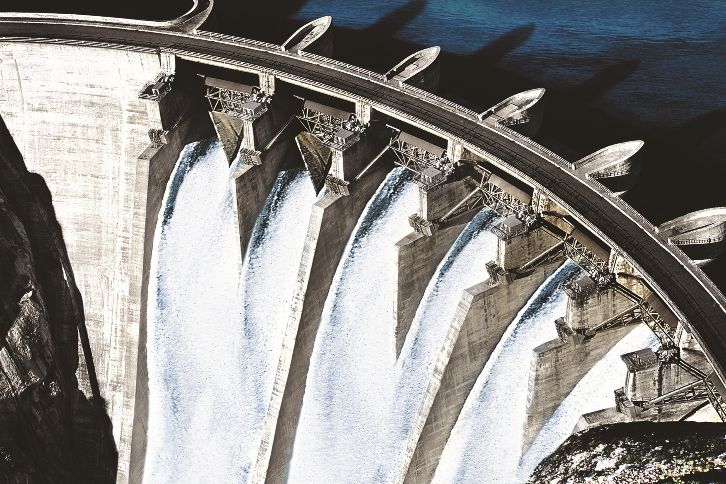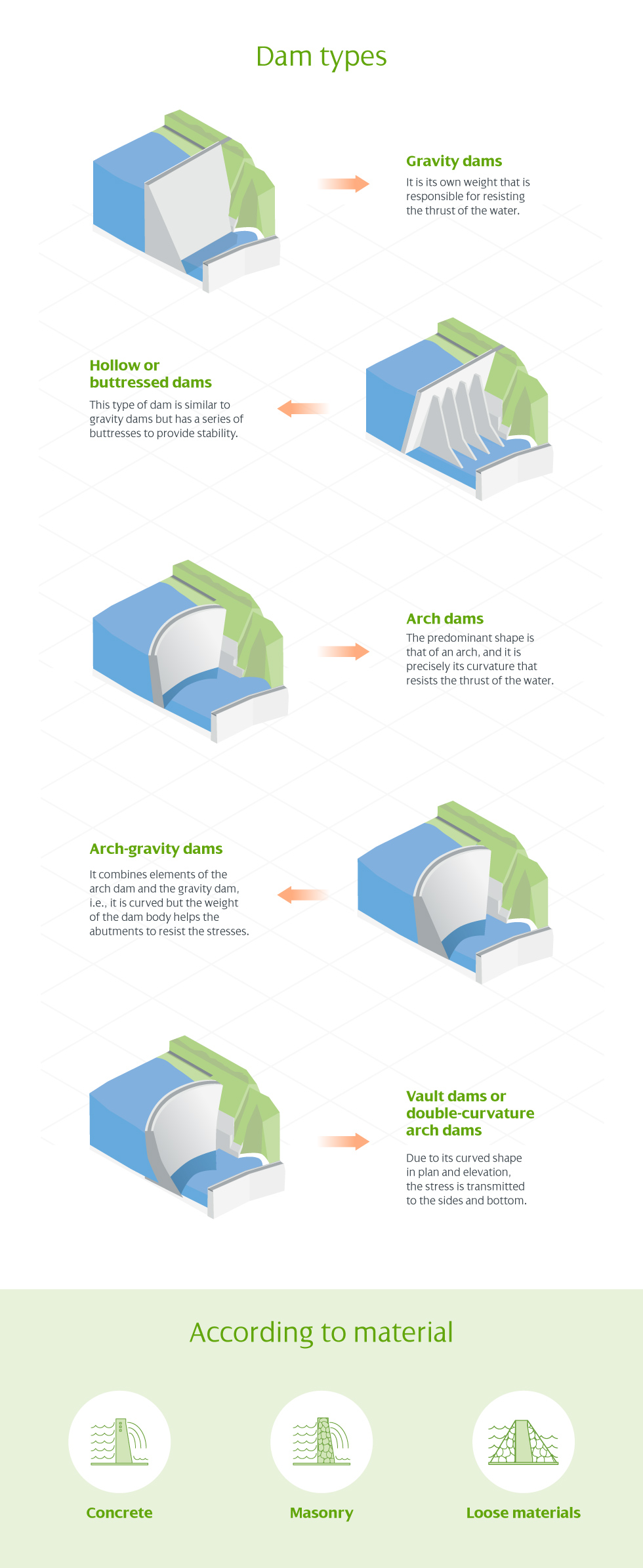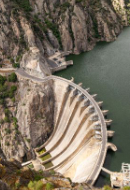Types of dams
What types of dams are there?
The dam is an essential element in a hydroelectric power plant because of its important function. It is the civil works infrastructure that makes it possible to impound the water that will subsequently drive the turbines of the power plant, generating clean electricity. There are different types of dams, either according to their materials or their mechanisms.
Since the Jawa dam was built in 3,000 BC in Jordan, considered the oldest dam in the world, this type of facility has evolved in terms of materials and shapes, adapting to the terrain in which it was built and the period in which it was constructed. In Ancient Egypt, several dams were built to cope with the flooding of the Nile River, and in the Roman Empire, the so-called Roman concrete, made of mortar and stones of all kinds, was used to build dams up to 50 metres high with structures unknown until then.
The types of dams have progressively adapted to the orography of the terrain and to the different uses of water. These two characteristics are what will determine the most suitable type of dam, always bearing in mind that they must fulfil a dual function: on the one hand, to resist the thrust of the water, and on the other, to evacuate it when necessary.
Types of dams or dikes according to their construction material
The types of dams can be classified according to the material of construction and according to their shape. If we look at the first classification, that of the construction material, we find three main types of dams:
 Concrete dams
Concrete dams
They are the most commonly used as they have very good performance in terms of durability, strength, impermeability and ease of construction, as well as a relatively low price. Concrete dams can be of the conventional type or of dry consistency that can be compacted with rollers.
In this type of dam, the so-called phenomenon of chemical expansion of concrete occurs, which reduces the useful life of the material due to degradation caused by a chemical reaction between the concrete's own components in the presence of water. For this reason, Iberdrola created the innovative HOREX project - an acronym for Hormigones Expansivos (Expansive Cements) - which makes it possible to determine whether the components of the concrete used for future dams will be reactive and to what degree to select them so that expansion does not occur.
 Masonry dams
Masonry dams
These are usually smaller dams, which mainly employ a structure of stone, sand and cement. Their construction is usually perpendicular to the gullies - the undercuts in the ground - in order to reduce the velocity of water runoff by forming steps that reduce erosion.
 Loose material dams
Loose material dams
Due to their low cost, they are the most commonly used in developing countries. They are filled with uncemented earth, normally stones and gravel, which provide the necessary resistance to the thrust of the water. To this are added impermeable screens made of other materials.
Types of dams or weirs according to their shape or structure
Another criterion for categorising dams is the shape or structure they have to cope with and retain the thrust of the water. In this sense, there are several types of dams
 Gravity dams
Gravity dams
They are known as gravity dams because it is their own weight that is responsible for resisting the thrust of the water. Normally built of concrete, which has a high density, the frictional force between the foundations and the dam is very high and is thus responsible for preventing sliding due to the thrust of the water. It is very important that the soil is very stable as it is responsible for supporting the weight of both the dam itself and the reservoir. For this reason, their shape resembles that of an isosceles triangle, the width of the base is usually around 80% of the height, and they can have a straight or curved axis.
Iberdrola has numerous dams of this type in Spain, such as the Torrejón, Villlalcampo, Saucelle and Castro dams.
 Arch Dams
Arch Dams
As the name suggests, in this type of dam the predominant shape is that of an arch, and it is precisely its curvature that resists the thrust of the water. It is important that a very high-strength material is used in the abutments of the downstream boundary - the sides of the dam - as this is where the greatest stress is produced. For this reason, this type of dam is limited by the topographical conditions, the more symmetrical the better, and by the orographic conditions of the terrain.
In turn, there are two other types of arch dams:
- The dams with vaults or double arches, in which, due to their curved shape in plan and elevation, the stress is transmitted to the sides and bottom. An example of this type of dam is the Almendra dam in Spain, which is emblematic for being the highest dam in the country.
- Arch-gravity dams combine elements of the arch dam and the gravity dam, i.e., it is curved but the weight of the body of the dam helps the abutments to resist the stresses. Large Iberdrola dams in Spain, such as those at Cedillo, Aldeadávila and San Esteban, are of the arch-gravity type.
 Hollow dams or buttress dams
Hollow dams or buttress dams
These types of dams are somewhat similar to gravity dams in that, in terms of their resistance mechanism, they have a series of buttresses to provide stability against sliding and overturning. Less material is used than in gravity dams, but they are more technically complex.
The José María de Oriol dam on the Tagus River, also known as "La Catedral", is a buttress dam.
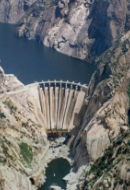
What is hydroelectric energy
Find out how hydroelectric power plants work.
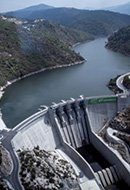
Terms hydropower
How many concepts associated with this renewable energy are we able to define?
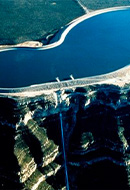
Pumped-storage hydropower plants
Do you know what pumped-storage hydropower stations are used for?
Iberdrola, at the forefront of large dams
Iberdrola has been committed to hydroelectric power since its origins and, for this reason, with more than 14,000 MW of installed capacity worldwide, it is a leader in energy storage with 4,500 MW of installed capacity through pumped hydroelectric storage plants. One of its most emblematic projects is the Tâmega hydroelectric complex in northern Portugal, which involves the construction of three dams, among other infrastructures.
In March 2021, the first filling of the Daivões reservoir was completed, which has a concrete "gravity arch" dam with a height of 77.5 m and a crest length of 265 m³, using 240,000 m³ of concrete.
In Spain, the Aldeadávila dam was a real milestone at the time of its construction and today it is still one of the highest dams in the country thanks to its height of almost 140 metres and its 250-metre crest length. Aldeadávila is capable of reserving 115 cubic hectometres in a surface area of 368 hectares, which is equivalent to almost 97 stadiums such as Madrid's Santiago Bernabéu.





